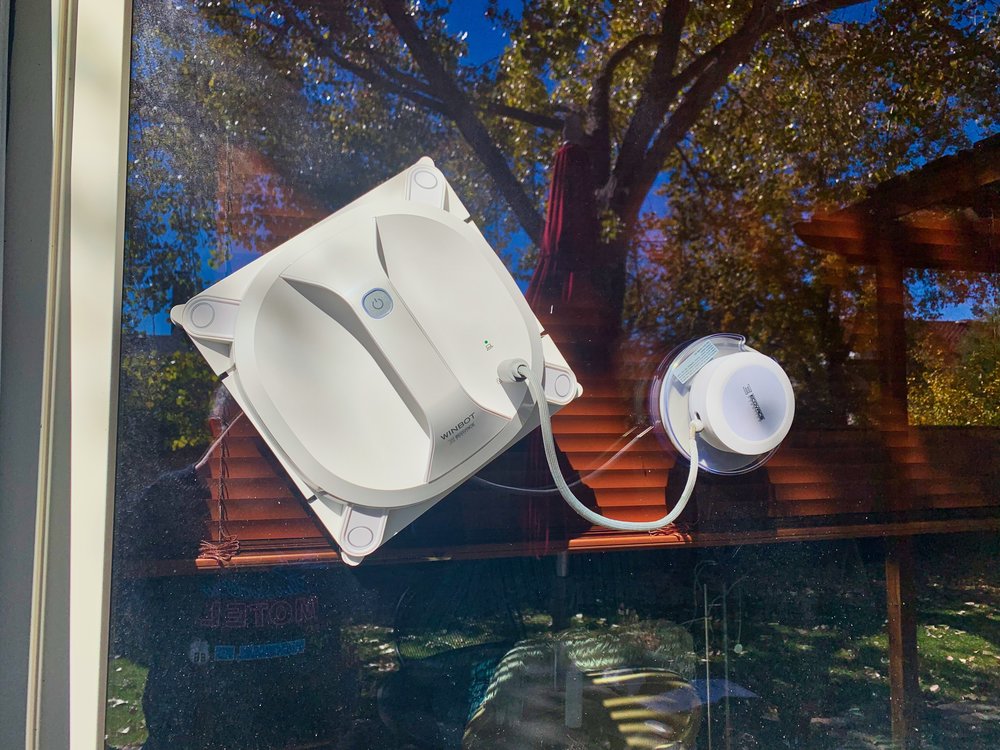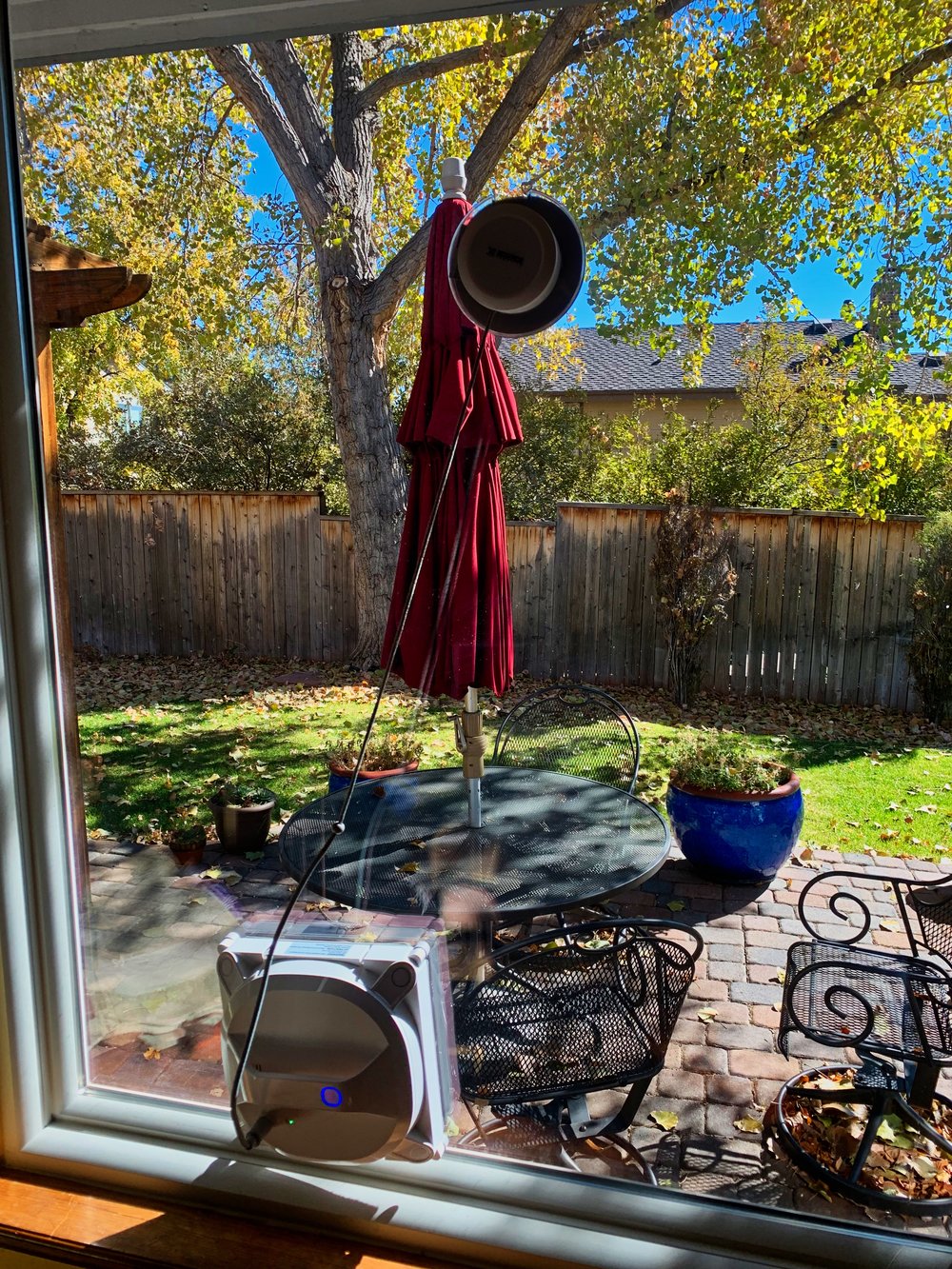Most people I know hate cleaning windows, which is why the Ecovacs Winbot X (US$449.99) window cleaning robot is such an attractive idea. The concept is exciting: slap a robot onto a window and let it move around for a while, leaving a crystal-clear view out of your window. In reality, though, I think Ecovacs might want to do a bit more work on making a window-cleaning robot that doesn’t require as much supervision.

I can’t fault the design of this robot; it’s actually very impressive. As you can see in the image above, there are two pieces to the Winbot X that are connected by a strong tether. The first is the Winbot itself, which uses strong suction to stick to the glass that it’s cleaning. The second is a smaller suction cup that sticks to the Window and monitors the robot. If either the robot or the suction cup are showing low suction, the robot emits alarms and the tether draws pulls the robot back to the suction cup. The idea is to keep the robot from ever falling off the glass — it’s heavy enough (3.9 lbs. / 1.77 kg) to do some real damage to people and property if it falls any distance.
There’s no app associated with this device; one button on the Winbot is used to get everything started. There is a remote control that allows you to start, stop or pause the device, but as you’ll see in the “Function” part of this review, Winbot seems to need personal supervision so you’ll most likely be standing near it anyway.
To clean your windows, you need to prepare Winbot by spraying a cleaning fluid (Ecovacs recommends using only their fluid, but in an email I was told that Windex or similar cleaners were OK to use) onto a four-sided washable pad that surrounds a central core. That core contains the port for the vacuum that basically “sucks” the Winbot onto your window, as well as a pair of rubber “tank tracks” that move the Winbot around.

Ecovacs refers to a 4-stage cleaning process on its website. What that really means is that as the Winbot moves over a piece of glass, it is wiped by one side of the damp cleaning pad, then by a squeegee, then by another squeegee, and finally by the other side of the cleaning pad. You can see the pad and the squeegees (as well as the drive tracks) in the image above.
Once Winbot has been prepared to clean your windows by dampening the cleaning pad all the way around, it’s time to get started. You begin by cleaning two spots on your dirty window, one for the suction cup to stick on, another for the robot to cling to. On a small window, by the time you’ve cleaned those two spots for the robot and tether system, you’ve already cleaned a good portion of the window…
Next, you connect the Winbot and suction cup with the tether, then hold the Winbot to the window and press the power button. You hear the “vacuum” start up, and soon the robot emits a sound letting you know that you can let go.
Winbot is designed to clean windows by moving in one direction until it reaches an edge, then running a back-and-forth zigzag pattern (avoiding the safety suction cup, of course) until the window is clean. At the end of that cleaning run, it’s supposed to return to its starting point so it can be easily retrieved.
Reality
I have a large, two-story house with a lot of windows that I’ve neglected, so I was really hoping that I’d be able to attach Winbot to a window, wander off to do something else, and come back to sparkling clear windows. The reality was a bit different …
First, I precisely followed the directions on wetting the pads prior to cleaning, and cleaned the two spots on the window (exterior) to allow for a perfect suction connection to the window. No problems there!
Next, I attached the safety suction cup to the window, connected the safety tether to the Winbot, then lifted the Winbot by its built-in handle up to the window surface. It really surprised me when this nearly 4-pound robot stuck to the window after I pushed the power button.
So far, so good. But when the Winbot started moving on the window, it wasn’t following the back and forth pattern. In fact, it moved a few inches, slewed about 45°, and then sat in one place humming away. I let it do that for about 30 seconds, then went over and gave it a little “push”.
That seemed to start it off, and it trundled across the glass and it looked like my window was going to be cleaned. Well, no sooner had it begun to clean in earnest than it ran into the safety suction cup and moved off in another direction, re-cleaning a section of glass that had already been cleaned. In fact, it never did clean some sections of the window, while focusing on other parts. You can see what I’m talking about in this short video:
One other thing that I noticed was that the cleaning pads dried out too quickly. I live in a part of the country (Colorado) where it’s not unusual to have 10 percent humidity, but it surprised me just how fast the pads became dry. I asked Ecovacs about this through their PR firm, and got a response that I could spray a bit more of the cleaning solution on the window itself to re-dampen the pads while cleaning was in progress.
Well, that meant that I had to stand next to the window during the entire cleaning cycle and watch for signs of the pads being dried. So much for being able to sit back and relax while my windows were being robot cleaned! The next issue I ran into was having the window be too wet from spraying the cleaning solution on either the pads or the window, which caused the “tank treads” to slip on the window so that the robot stayed stuck in one place.
I have to give Ecovacs kudos on battery life on the Winbot X. It lasted the specified 50 minutes trying to clean the outside and inside of one window, which was actually pretty impressive. It’s also nice that you don’t need to actually plug the Winbot X into an outlet while cleaning.
I had somewhat better luck when cleaning a sliding glass door. I was able to place the safety suction cup on one part of the two-part door while cleaning, so it didn’t get in the way of the robot. Winbot was able to follow its cleaning path without too much of a problem, but I still needed to keep a close eye on the robot to make sure those cleaning pads were damp enough to clean, but not so damp as to cause the robot to slip and stay in one place.
Now, my windows had been neglected for a while, so I found that the Winbot cleaning pads got dirty very quickly and started to streak the windows. I’d recommend that any potential buyers have all of their windows cleaned professionally inside and out before purchasing a Winbot X to do the regular maintenance cleaning.

The Bottom Line
Will I continue using the Winbot X to clean my windows? Sure, but I’m taking my own advice and making sure all those windows are manually cleaned before I start doing maintenance cleaning with the robot.
I also realize that I’m going to have to pay attention to the cleaning process, but since watching a robot move around my windows is still easier than washing those window myself, I think that’s a fair tradeoff.
If there’s one thing I wish that Ecovacs would consider for future window-cleaning robots, it’s adding an onboard tank for the cleaning solution and putting moisture sensors in the pads, so those cleaning pads are always at the optimum dampness for good cleaning and no sliding of the movement treads.
Given all of the caveats I’ve listed in this review and the hefty price of the Winbot X, I’m not sure I can recommend purchasing it unless you’re willing to pre-clean your windows prior to the first maintenance cleanings by the robot and realize that you’re going to need to keep an eye on the robot while it cleans.
Apple World Today Rating (out of 5 stars): ★★★
